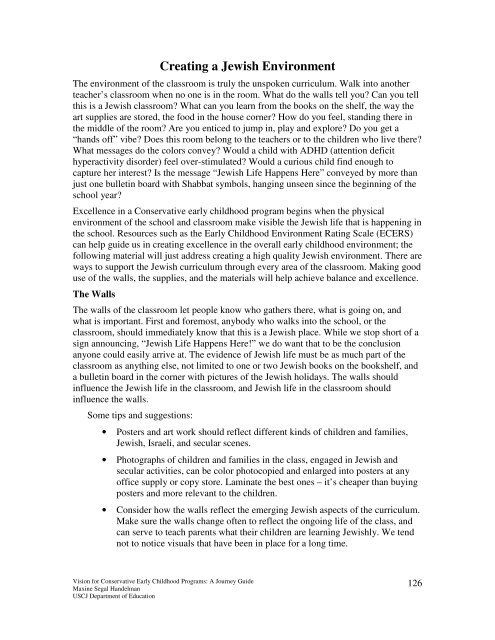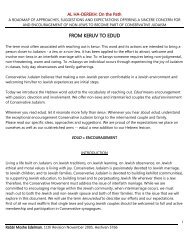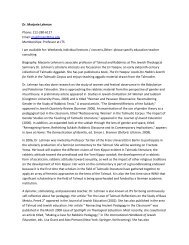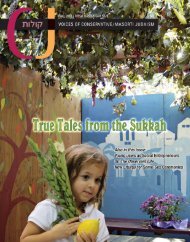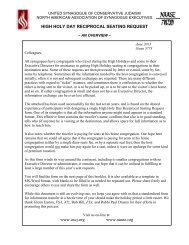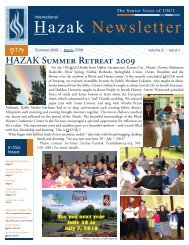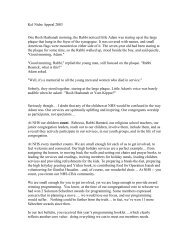Vision for Conservative Early Childhood Programs: A Journey Guide
Vision for Conservative Early Childhood Programs: A Journey Guide
Vision for Conservative Early Childhood Programs: A Journey Guide
Create successful ePaper yourself
Turn your PDF publications into a flip-book with our unique Google optimized e-Paper software.
Creating a Jewish Environment<br />
The environment of the classroom is truly the unspoken curriculum. Walk into another<br />
teacher’s classroom when no one is in the room. What do the walls tell you? Can you tell<br />
this is a Jewish classroom? What can you learn from the books on the shelf, the way the<br />
art supplies are stored, the food in the house corner? How do you feel, standing there in<br />
the middle of the room? Are you enticed to jump in, play and explore? Do you get a<br />
“hands off” vibe? Does this room belong to the teachers or to the children who live there?<br />
What messages do the colors convey? Would a child with ADHD (attention deficit<br />
hyperactivity disorder) feel over-stimulated? Would a curious child find enough to<br />
capture her interest? Is the message “Jewish Life Happens Here” conveyed by more than<br />
just one bulletin board with Shabbat symbols, hanging unseen since the beginning of the<br />
school year?<br />
Excellence in a <strong>Conservative</strong> early childhood program begins when the physical<br />
environment of the school and classroom make visible the Jewish life that is happening in<br />
the school. Resources such as the <strong>Early</strong> <strong>Childhood</strong> Environment Rating Scale (ECERS)<br />
can help guide us in creating excellence in the overall early childhood environment; the<br />
following material will just address creating a high quality Jewish environment. There are<br />
ways to support the Jewish curriculum through every area of the classroom. Making good<br />
use of the walls, the supplies, and the materials will help achieve balance and excellence.<br />
The Walls<br />
The walls of the classroom let people know who gathers there, what is going on, and<br />
what is important. First and <strong>for</strong>emost, anybody who walks into the school, or the<br />
classroom, should immediately know that this is a Jewish place. While we stop short of a<br />
sign announcing, “Jewish Life Happens Here!” we do want that to be the conclusion<br />
anyone could easily arrive at. The evidence of Jewish life must be as much part of the<br />
classroom as anything else, not limited to one or two Jewish books on the bookshelf, and<br />
a bulletin board in the corner with pictures of the Jewish holidays. The walls should<br />
influence the Jewish life in the classroom, and Jewish life in the classroom should<br />
influence the walls.<br />
Some tips and suggestions:<br />
• Posters and art work should reflect different kinds of children and families,<br />
Jewish, Israeli, and secular scenes.<br />
• Photographs of children and families in the class, engaged in Jewish and<br />
secular activities, can be color photocopied and enlarged into posters at any<br />
office supply or copy store. Laminate the best ones – it’s cheaper than buying<br />
posters and more relevant to the children.<br />
• Consider how the walls reflect the emerging Jewish aspects of the curriculum.<br />
Make sure the walls change often to reflect the ongoing life of the class, and<br />
can serve to teach parents what their children are learning Jewishly. We tend<br />
not to notice visuals that have been in place <strong>for</strong> a long time.<br />
<strong>Vision</strong> <strong>for</strong> <strong>Conservative</strong> <strong>Early</strong> <strong>Childhood</strong> <strong>Programs</strong>: A <strong>Journey</strong> <strong>Guide</strong><br />
Maxine Segal Handelman<br />
USCJ Department of Education<br />
126


